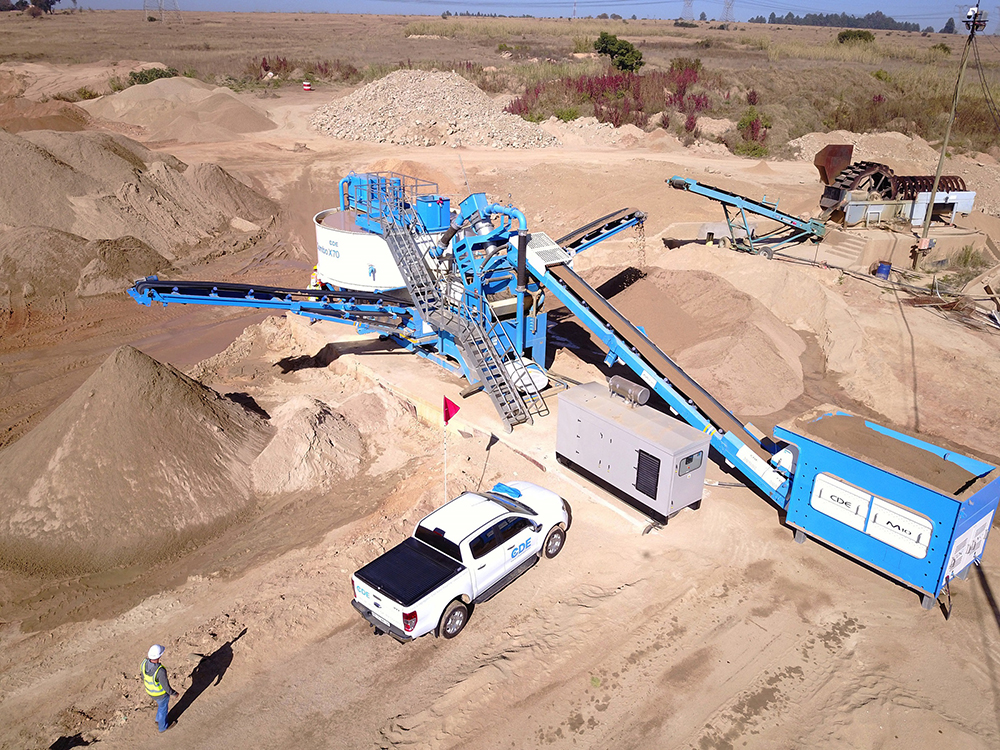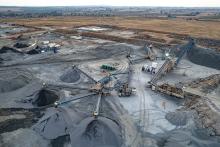Having started producing sand and aggregates out of decomposed granite back in November 2016, Ground Breakers – the brainchild of two young South African entrepreneurs with a background in plant hire, logistics and quarrying industries – is fast becoming a sand producer of choice within its area of supply.
Within three years of operation, Ground Breakers – owned by Johan Meintjes and JC Janse van Vuuren – has established itself as a leading supplier of construction materials. Operating from its Lindley quarry in Johannesburg, the company produces an array of construction materials, including G5, G6, G7, building sand, river sand and plaster sand.
At the centre of its market leading position is the quality of its sand and the flexibility to produce to customer spec. Key to these capabilities is the recent investment in CDE’s patented Combo – the world’s first all-in-one wet processing plant.

Before investing in the CDE Combo, Ground Breakers previously deployed a bucket wheel system to transform the quarry’s raw feed of decomposed granite into construction sand and aggregates, with additional low-value fill or bedding products.
Bucket wheel systems have traditionally been the mainstay for washing sand in South Africa. They were cheap to buy, however, a major downside is that up to 37% of valuable fine sand is lost to slime dams, reasons Willem du Plooy, business development manager at CDE South Africa.
Consequently, an upgrade of the existing bucket wheel system was required to tackle the loss of valuable materials to ponds and excess moisture in the final products. “Our quarry site in Lanseria faced a lot of challenges; we had limited water sources and space to put up a proper wash plant. Any silt dams we dug were taking away valuable mining area,” explains Meintjes.
“The market required a clean washed concrete sand, and our bucket wheel was not delivering a quality product. We also lost a lot of fines to the settling ponds. We knew that to grow the business we had to find a more sustainable and efficient washing solution,” adds Janse van Vuuren.
Explaining some of the downsides of the conventional system, Du Plooy says a bucket wheel is basically a water in, water and sand out overflow system, with no defined separation parameters. The more water in the system, the more the sand loss. The less the water in the system, the more silt in the sand. “It’s a very difficult balancing act,” he says.
“As bucket wheels struggle to process sufficient volumes of water to achieve the desired cut points, fines are not efficiently removed and 100-300 micron fractions are lost to ponds or to the water treatment phase along with the overflow, making the sand product coarser. To mitigate the risk of inaccurate material classification, bucket wheels’ settings must be adjusted on a regular basis,” says du Plooy.
Diverting excess material to settling ponds requires considerably more space to accommodate the latter, and classification efficiency decreases as the proportion of fines in the feed material grows. The time then required for clearing out settling ponds to recover lost material requires long periods of plant downtime.
“To give an idea, after three days of operation with the old bucket wheel system, they had to stop production because the accumulated silt would be too excessive in the system,” explains Du Plooy.
Outside of the issue of high maintenance costs for a restricted throughput, the sand product typically discharged from the Ground Breakers’ bucket wheel system contained between 23% and 25% of moisture. The high moisture content meant that stockpiling the final product required double – sometimes triple – handling (to move the material to a separate stockpile area).
Following a visit by CDE experts, Ground Breakers’ feed material was tested at CDE’s laboratory. Based on the analysis results, CDE engineers established that the customer could make significant savings by adopting cyclone technology to eliminate the loss of fines to ponds. This would help to retain every valuable grain of sand available in the system and reduce the size of the settling ponds as well as maintenance time. In addition, CDE technology could add a plaster sand product to the company’s offer, which has higher commercial value than the river sand currently processed.
After considering the site’s footprint and the customers’ requirements, CDE presented the Combo all-in-one wet processing and water recycling system as the most appropriate solution to the customer’s requirements. The Combo would allow them to produce two high-quality sands simultaneously from the raw feed including plaster sand and river sand, for a much faster return on investment.
Incorporated cutting-edge water management would ensure that the final products would be dewatered to an average 12% moisture, making them ready for market straight from the belts. As an added benefit, the fully integrated CDE AquaCycle thickener would allow for up to 90% of the process water to be recycled directly into the system for near-independence from fresh water supplies.
Following a collaborative design process with the customer, CDE developed and built a Combo modular plant to transform 60 tonnes per hour of raw feed into washed 0-6mm river sand and 0-1.5mm plaster sand.
The Ground Breakers’ bucket wheel was not effectively reducing moisture in the sand products and fines were lost to ponds. To address these limitations, the Combo’s high-frequency dewatering screen dewaters the material in one pass, removing the need for re-processing and double handling. Once the sand slurry with the silt material is discharged from the hydrocyclones, it is delivered to the screen, which is sized according to the customers’ specific capacity requirements.
This allows for the production of a sand product with a moisture content typically ranging from 10% to 15%. As a result, the product is ready for market straight from the belts, in turn converting sand into revenue in the shortest possible time. An added benefit of the Combo system is that although the plant packs a powerful punch, it only requires a very small footprint, which makes it easy to relocate, even in remote areas and urban settings.
“Our CDE Combo is compact and highly efficient. It produces two properly washed products and our customers are very happy that the moisture content is so low. This means a considerable cost saving to them, as generally we sell per tonne,” says Meintjes.
“Because the system works basically as a full-circuit unit, retaining fines and recycling used water for immediate re-use in the system, the need for silt dams has been significantly reduced and we have been able to preserve valuable mining areas,” adds Janse van Vuuren.
Switching from a bucket wheel system to the Combo has ushered in massive production gains. Firstly, production has tripled, from around 20 tonnes per hour to between 60-80 tonnes per hour. “The old system also lacked consistency because the plant would get blocked more often,” says Janse van Vuuren.
“The Combo has also been conducive to considerable cost savings, as generally we sell per tonne. The additional -2 mm product has many uses, from plastering exterior walls to making paving bricks. It has increased our profitability considerably,” adds Meintjes.
“The new Combo on the Lanseria site has allowed the company to maximise yield and reduce its operational costs. The production of sand and aggregates is guaranteed to be within specifications, with no risk of cross-contamination when two products are processed simultaneously, and in line with the requirements of customers or their downstream processes,” says Du Plooy.
According to Du Plooy, another major gain of installing the Combo is the flexibility. It allows Ground Breakers to produce more than two products by manipulating the amount of fines or course material. This allows Ground Breakers to spec the material according to specific client needs. Apart from the flexibility offered by the conveyor system, one can also put in different size screens to change the product spec.
In fact, when we visited the site, CDE and Ground Breakers were working on a spec change on the plant. Originally the cut size on the fine sand was 1,5 mm. Ground Breakers had a request from one of the clients for the cut size to get closer to 3 mm. By changing some of the panels on the screen, the production team is now able to change the cut size to the required 3 mm cut.
“At CDE we put all our passion and expertise in developing equipment that is tailor-made for each client to the highest quality standards. Return on investment is fast thanks to reduced requirements for spares, highly efficient water management as well as longer and more reliable running time,” concludes Du Plooy.







